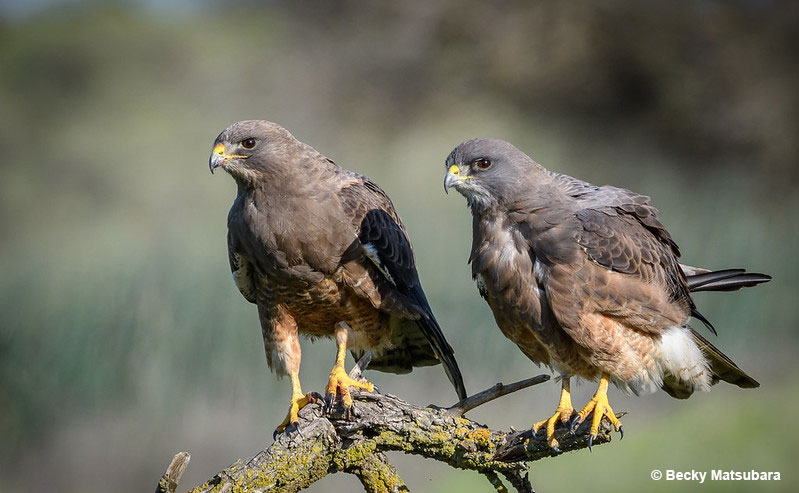
Go for a walk in Maine and a small Sharp-shinned Hawk could zip through your field of view. With luck, you might see a big Northern Goshawk in the forest, and will see Red-tailed Hawks in every part of the state.
Which hawk species in Maine are the most common? How can you tell hawks in Maine apart?
Most Common Hawks In Maine
There are around eight commonly seen hawk species in Maine. There can be more in the form of rare vagrants, but the rest are fairly common. However, some species are seen more often than others.
To figure out which hawks in Maine were seen the most, we leaned on recent eBird data and arranged the birds from most common to least common. To help with identification, we also included key field marks and information about their behavior.
We hope this list helps with your hawk-watching in Maine!
Red-tailed Hawk
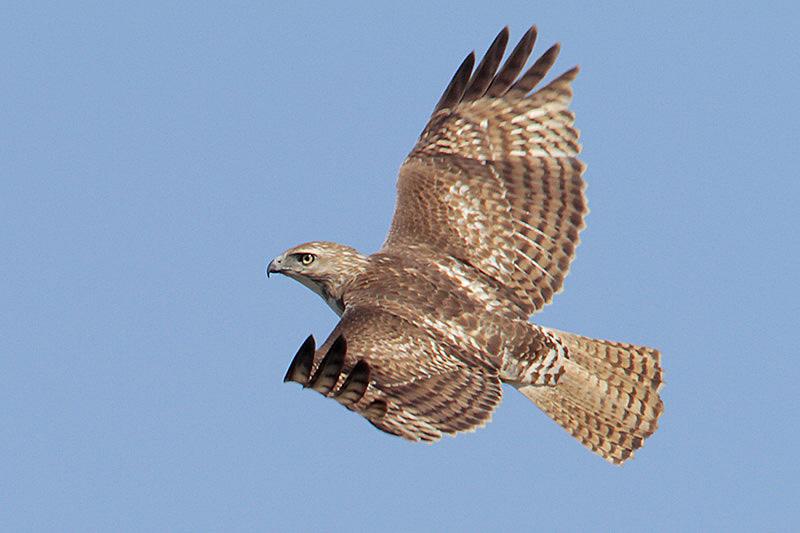
Red-Tailed hawk (Juvenile) © Greg Lavaty.
Scientific name: Buteo jamaicensis
Speed: 20-40 miles per hour
Length & Weight: 19 inches, 2.4 pounds
Wingspan: 49 inches
Call: “keeeyah!”
The Red-tailed Hawk is a big and bulky hawk with dark brown upperparts and long, broad wings. Adults have a broad reddish tail and both sexes are similar (although females are larger than males).
In the east, adults have pale underparts with dark marks on their belly but western birds can be dark brown, buff, or reddish-brown below. Young birds have brown tails with darks barring.
In flight, all Red-tailed Hawks show a large, somewhat square-shaped, pale area near the tips of their wings.
This species preys on a variety of small animals, including squirrels, rats, snakes, and birds. It catches prey by swooping down from a perch or from soaring flight. In some unlucky cases, they might even go for the state bird of Maine.
Red-tailed Hawks build a messy stick nest high in a tree or on the ledge of a building.
They use a wide range of habitats and are commonly seen in Maine.
Key Identifications:
- Large, hefty hawk with a reddish tail and dark marks on its pale belly.
- Preys on small mammals, snakes, and birds.
- Builds a bulky stick nest high in a tree.
- Makes loud, jay-like, ringing calls, “keeeyah!”.
Broad-winged Hawk
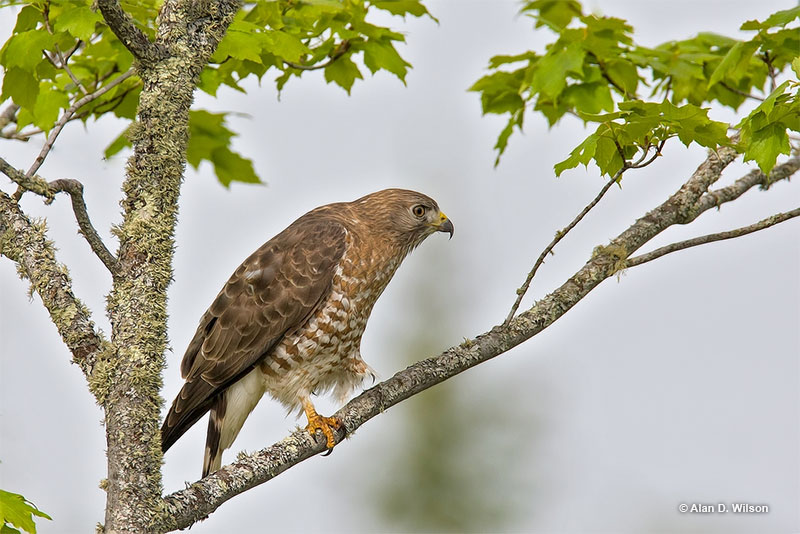
Scientific name: Buteo platypterus
Speed: 20-40 miles per hour
Length & Weight: 15 inches, 14 ounces
Wingspan: 34 inches
Call: “sipeeeeeeeee”
The Broad-winged Hawk is a smallish raptor around the same size as a crow. Adults are dark brown above, have dark, reddish-brown barring below, and a broad tail with a few wide, white bands.
Both sexes look the same and also have a thick dark mark on each side of their throat, although females are larger. Young birds have dark brown streaks on pale underparts.
In flight, this species often soars, shows a broad black and white tail, and has long wings shaped like a “paring knife” that also have a dark trailing edge.
This raptor preys on voles, frogs, insects, and other small animals. It catches food by waiting on a perch and then quickly swooping down to the ground.
This small hawk breeds in forest habitats.
Key Identifications:
- Chunky, smallish, crow-sized hawk with a few white bands on its tail and underparts with brown barring or streaks.
- Preys on insects and small animals in woodland habitats.
- Builds a bulky nest high in a tree.
- Makes a high-pitched call, “sipeeeeeeeee”
Cooper’s Hawk
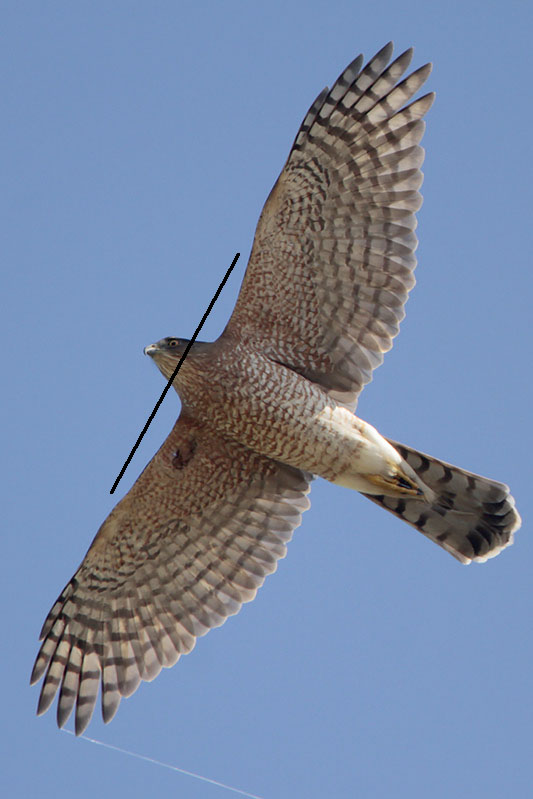
Scientific name: Accipiter cooperii
Speed: 21-55 miles per hour
Length & Weight: 16.5 inches, 1 pound
Wingspan: 31 inches
Call: “kek kek kek kek kek!”
The Cooper’s Hawk is a fair-sized hawk with a long, rounded tail and a blocky, square-shaped head. Adults are blue-gray above and have orange barring below.
Both sexes look similar although females are larger. They also often show a dark cap, have pale grayish on their face and side of the neck, and dark banding on their tail.
Young birds are shaped like adults but are dark brown above, have paler brown on the head, and fine dark streaking on pale underparts.
In flight, this species uses its rounded wings to make a few deep flaps followed by a brief glide.
The Cooper’s Hawk preys on doves and other medium-sized birds, and small mammals. It usually catches them on the ground and frequently attacks birds at feeders.
This species lives in a variety of wooded and semi-wooded habitats.
Key Identifications:
- Fair-sized hawk with orange barring below, blue gray above, and a long rounded tail.
- Preys on small mammals and starlings and dove-sized birds in woodlands, parks, and towns.
- Builds a bulky stick nest high in a tree.
- Usually quiet but when breeding, it makes a loud barking call, “kek kek kek kek kek!”
Northern Harrier
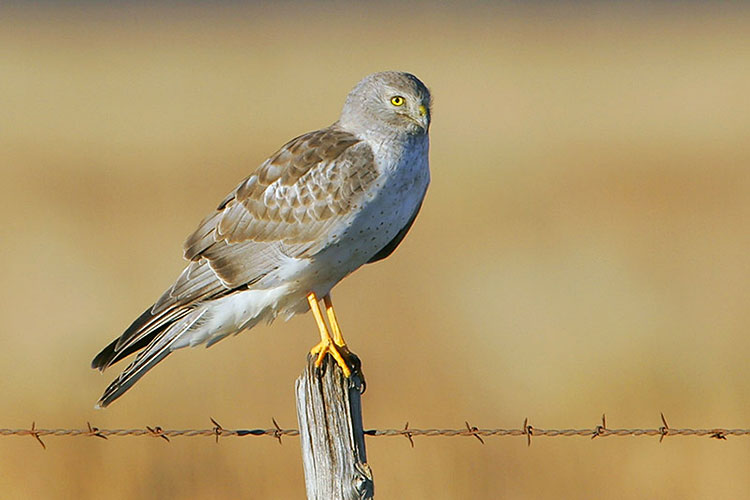
Scientific name: Circus hudsonius
Speed: 21-38 miles per hour
Length & Weight: 18 inches, 15 ounces
Wingspan: 43 inches
Call: “che che che che che che”
The Northern Harrier is a fair-sized, unique hawk with long wings, a long tail, and a white rump. Adult males have gray upperparts, head, and breast. They also have some pale brown spotting on their underparts and black tips on their wings.
Females are dark brown above and have dark brown streaks on pale underparts. Young birds are also dark brown above but have deep orange-buff underparts.
All Northern Harriers have a white rump and glide low over the ground on long wings held in a “V” shape.
This species preys on small animals caught on the ground, sometimes after hovering.
Northern Harriers breed in grasslands and other open habitats. They use grass and other vegetation to make a shallow, platform nest on the ground, in thick wetland or grassland areas.
Key Identifications:
- Distinctive long-winged, long-tailed hawk with a white rump.
- Glides low over the ground to catch rodents and other small animals in marshes and other open grassy habitats.
- Builds a platform nest on the ground, in tall thick grass.
- Makes a repetitive, woodpecker-like call, “che che che che che che”
Sharp-shinned Hawk
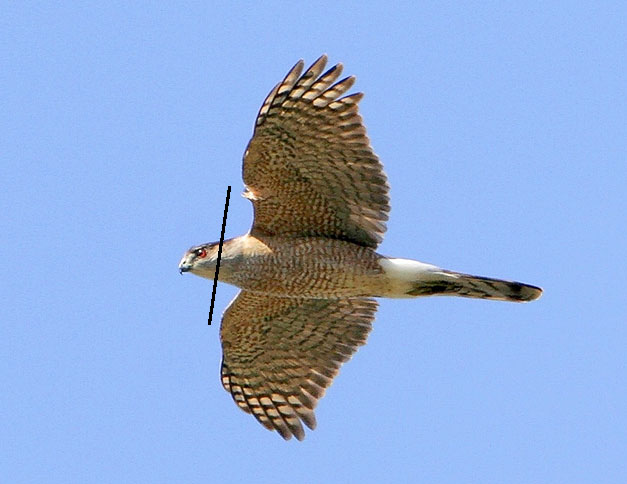
Scientific name: Accipiter striatus
Speed: 16-60 miles per hour
Length & Weight: 11 inches, 5 ounces
Wingspan: 23 inches
Call: “kew kew kew kew kew kew kew kew”
The Sharp-shinned Hawk is a small hawk with a long, rectangular tail and rounded wings. Adults have blue-gray upperparts, orange barring on their underparts, and dark bands on their tail.
Females are larger than males and young birds are dark brown above with thick brown streaks on pale underparts.
This species flies with several quick wing beats followed by brief glides. When flying, its head doesn’t stick out as much as a Cooper’s Hawk and it shows a square-tipped tail.
The Sharp-shinned Hawk preys on small birds up to the size of an American Robin. It mostly catches birds around the same size as sparrows, warblers, and vireos by quickly flying and catching them in vegetation.
This hawk builds a bulky stick nest high in a conifer.
Sharp-shinned Hawks live in wooded habitats and are present year-round.
Key Identifications:
- Small hawk with rounded wings and a long, rectangular tail.
- Preys on small birds in woodland habitats.
- Builds bulky stick nest high in a conifer.
- Usually quiet but on breeding grounds makes falcon-like, repeated ringing calls “kew kew kew kew kew kew kew kew”.
Red-shouldered Hawk
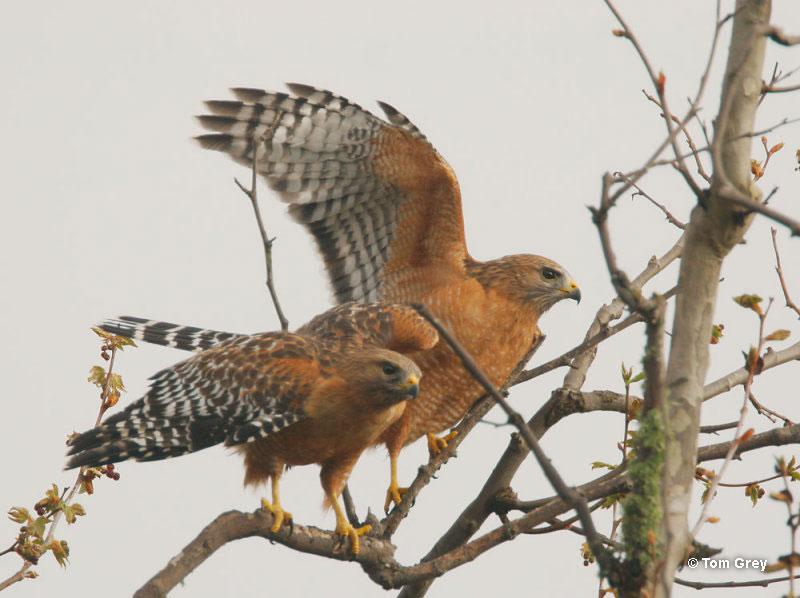
© Tom Grey
Scientific name: Buteo lineatus
Speed: 18-34 miles per hour
Length & Weight: 17 inches, 1.4 pounds
Wingspan: 40 inches
Call: “keer keer keer keer keer!”
The Red-shouldered Hawk is most common hawk in Florida. It is a medium-sized hawk with reddish-orange underparts and shoulder, and black and white on its wings and tail.
Both sexes are similar but as with most raptors, females are larger than males. Young birds are brown above and have dark streaks on pale underparts.
In flight, all ages of this hawk species are best recognized by their longish, black and white tail and long wings with a pale crescent-shaped mark near the tip of the wing.
Red-shouldered Hawks prey on snakes, frogs, and other small animals. They forage by waiting on a perch and then swooping down to catch the animal on the ground.
This species builds a bulky stick nest high in a tree in wooded and semi-wooded areas, often near wetlands.
The Red-shouldered Hawk lives in a variety of woodland habitats.
Key Identifications:
- Medium-sized, colorful hawk with reddish-orange underparts and shoulder, and black and white upperparts and tail.
- Forages for snakes and other small animals on the ground in woodland habitats.
- Builds a bulky stick nest high in a tree.
- Makes loud, jay-like, ringing calls, “keer keer keer keer keer!”
Northern Goshawk
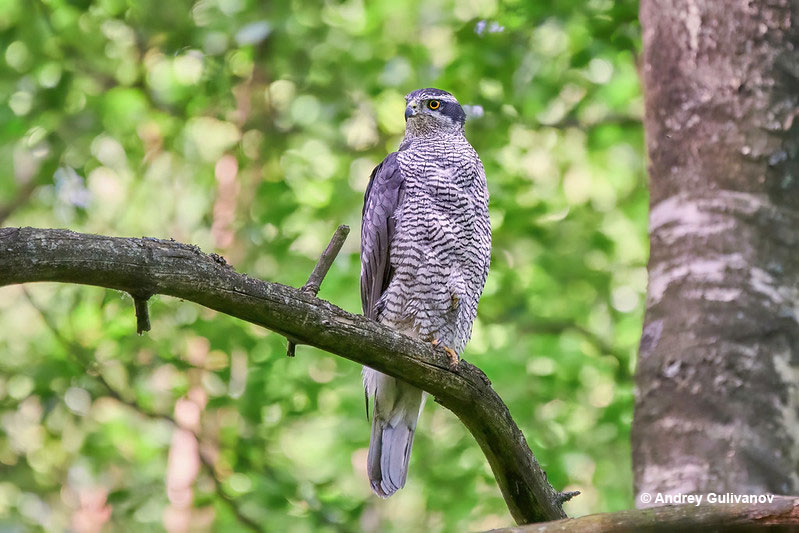
© Andrey Gulivanov
Scientific name: Accipiter atricapillus
Speed: 30-40 miles per hour
Length & Weight: 19 inches, 2 pounds
Wingspan: 40 inches
Call: “kip kip kip”
The Northern Goshawk is a large, hefty hawk with a long, banded tail, and rounded wings. Adults look similar but females can be 25% larger. Both sexes are gray above and white below with fine gray barring. They also have a dark cap and cheek, red eyes, and a white eyebrow.
Young birds are dark brown above with some pale spotting, have a pale eyebrow, uneven dark bands on their tail, and heavily streaked underparts.
In flight, Northern Goshawks make a few deep flaps followed by long glides.
This powerful raptor preys on squirrels, other small mammals, and grouse, woodpeckers, and many other mid-sized birds. They catch prey on the ground or by quickly flying through vegetation to grasp the unlucky animal with their talons.
In North America, Northern Goshawks live in coniferous and other wild wooded habitats. Their population is quite small in Maine, but they are still seen year-round.
Key Identifications:
- Hefty, long-tailed hawk with gray plumage or brown, streaked plumage, and a white eyebrow.
- Preys on fair-sized birds and mammals in coniferous forest habitats.
- Builds a bulky, stick nest high in a tree.
- Makes a repeated call, “kip kip kip kip kip kip kip kip kip kip kip”.
Rough-legged Hawk
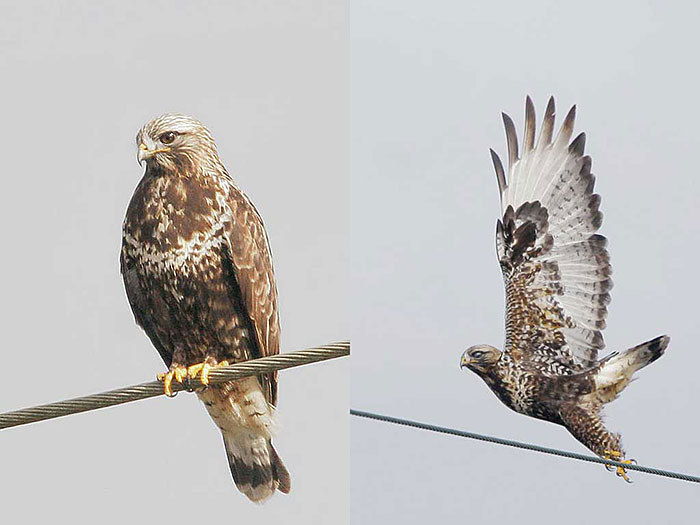
Photograph © Tom Grey
Scientific name: Buteo lagopus
Speed: 22-28 miles per hour
Length & Weight: 22 inches, 1.3 to 3.6 pounds
Wingspan: 53 inches
Call: “reeaaaauh!”
The Rough-legged Hawk is a long-winged hawk with a black and white tail. There are two color morphs; both with broad white patches near dark wing tips, and a longish pale tail with a broad black tip.
Pale females and juveniles are pale gray-brown with a black belly and black “wrists” in their wings. Pale adult males are more cold gray, have less black on their belly, and heavily streaked breasts.
Dark females and juveniles are dark brown except for their tail and flight feathers. Dark adult males are black except for their flight feathers and tail.
In flight, this species holds its wings in a shallow “V.”
Rough-legged Hawks soar and hover over open fields where they prey on voles and other small animals.
It builds a bulky nest on a cliff or rocky outcropping.
The Rough-legged Hawk breeds in tundra, but some birds winter on the open fields of Maine.
Key Identifications:
- Big hawk with a longish black and white tail, and long wings with broad white patches near the dark wing tips.
- Preys on rodents and other small animals in wide open habitats.
- Builds a big, bulky nest on cliffs and rocky outcroppings in tundra.
- Makes a loud, clear descending call, “reeaaaauh!”.
Swainson’s Hawk (vagrant)
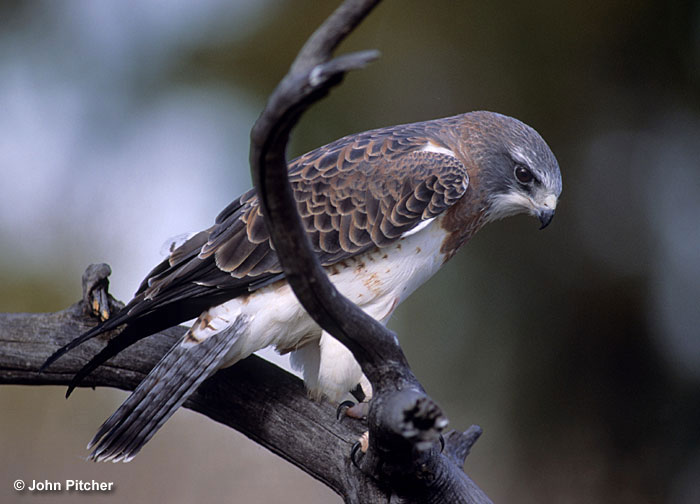
Scientific name: Buteo swainsoni
Speed: 15-60 miles per hour
Length & Weight: 19 inches, 1.9 pounds
Wingspan: 51 inches
Call: “eeeah!”
The Swainson’s Hawk is a big hawk with dark-brown upperparts, long, pointed wings with dark flight feathers, and a broad tail with fine dark barring and a dark tip. Males and females are similar although females are larger.
Adults can have a white throat, front, wing linings, and underparts with a red-brown breast. They can also have a white throat and front, and reddish brown underparts and wing linings, or be entirely dark brown.
Young birds can have dark markings on pale underparts or be mostly dark below.
This species catches grasshoppers and small animals on the ground. It forages by soaring and then swooping down or walking on the ground.
Swainson’s Hawks breed in grasslands, meadows, and other open habitats in central and western Canada and the USA. If this sounds odd, it’s because it is. Swainson’s Hawks usually keep towards the west, but in some cases, they might run off their course.
Key Identifications:
- Large, long-winged hawk with dark flight feathers and a broad tail with fine dark banding and a dark tip.
- Feeds on insects and small animals in prairies and other open habitats.
- Builds a bulky stick nest in a tree.
- Makes a loud, descending, single note, “eeeah!”.
Frequently Asked Questions
Are hawks common in Maine?
Yes, hawks are common in Maine. Twelve hawk species have been found in Maine, four of which are rare vagrants.
What is the biggest hawk in Maine?
The biggest hawk in Maine is the Rough-legged Hawk. It is 21 inches long and has a wingspan of 4.4 feet.
What is the smallest hawk species in Maine?
The smallest hawk species in Maine is the Sharp-shinned Hawk. Some male Sharp-shinned Hawks are only a little bit larger than an American Robin!
Do hawks hunt other birds?
Yes, several hawks hunt other birds. Cooper’s Hawks, Sharp-shinned Hawks, and Northern Goshawks specialize on hunting birds.
More in Maine: Most Common Birds | Owls | Ducks | State Bird

